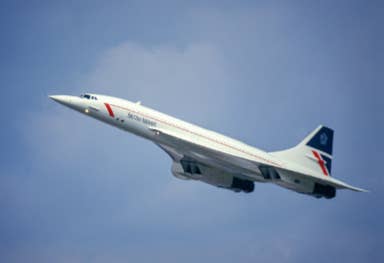
Farnborough, United Kingdom – September 10, 1986: Concorde making a pass at an airshow [iStock]
“Paris is always a good idea.”
Though Audrey Hepburn didn’t actually deliver that line in her 1954 film Sabrina, it’s widely attributed to her, and having lived in Paris for three years, I couldn't agree more. To this day, I never need an excuse to go. I’d happily hop the pond to La Ville-Lumière for the opening of an envelope.
But on one day in April 2000, Paris became a great idea, an incredible idea, une très, très bonne idée—no, that’s not hyperbolic enough. On one April day, Paris became the best idea ever, as I booked myself on Air France Flights AF001 and AF002 aboard Concorde for a round trip from New York’s John F. Kennedy International Airport (KJFK) to Paris’ Charles de Gaulle Airport (LFPG).
To say a flight on Concorde (not “the” Concorde) was unlike one on any other commercial aircraft is an understatement. The delta-winged Concorde was a truly unique airplane and an extraordinary feat of aeronautical engineering, especially for its time. Incorporating groundbreaking technologies like fly-by-wire, it was as stunning and graceful as it was swift, scorching the stratosphere at altitudes high enough to make a flat-earther blush. On my particular flights, we got up to FL580 and Mach 2.02—faster than a bullet and high enough to plainly see the curvature of the Earth.
- READ MORE: Tripping the Light Fantastic
From its first flight a few months before Neil Armstrong and Buzz Aldrin walked on the moon to its first commercial flights in 1976—G-BOAA, London to Bahrain and F-BVFA, Paris to Rio de Janeiro via Dakar, Senegal—to its final flights 27 years later, Concorde captured hearts, minds, and dreams around the world. Coincidentally, F-BVFA is also the airplane I flew on from New York City to Paris. It is now on display at the National Air and Space Museum’s Steven F. Udvar-Hazy Center.
Tuesday, October 24 marks the 20th anniversary of the final scheduled commercial flights of Concorde. On that day, British Airways Concorde G-BOAG, as BA002, took off from JFK, with chief pilot Mike Bannister at the controls, and landed at London’s Heathrow Airport (EGLL) a scant few hours later, but not before “Alpha Golf” formed up with two other Concordes for a low formation pass over London.
Alpha Golf is now on display at the Museum of Flight in Seattle. On its way to retirement—because of course it did—G-BOAG set a New York-to-Seattle speed record of 3 hours, 55 minutes, 2 seconds, flying supersonic over Canada along the way. As one would expect, Concorde holds many speed records, including the fastest Atlantic crossing and New York to London in 2 hours, 52 minutes, 59 seconds.
The final scheduled passenger flight for an Air France Concorde came earlier in 2003 on May 31. That morning, Concorde F-BTSD, as AF001, departed JFK at 8:15 a.m. and landed at 4:30 p.m. local time in Paris. That airframe is on display near Paris at the National Air and Space Museum of France, located at Paris Airport-Le Bourget (LFPB) .
There are just three Concordes on display in the U.S. In addition to the two mentioned earlier, British Airways G-BOAD is preserved at the Intrepid Sea, Air & Space Museum in New York City.
I recently caught up with both Bannister and John Tye, another British Airways Concorde captain, and asked them both what they thought about this anniversary.
“I was fortunate enough to fly that last flight from New York to London,” said Bannister. “Every time I go to Brooklands [Museum near London] and look at the stylish lines of our Concorde there, she still looks like she was designed only a few years ago, very 21st century. I also still find it difficult to get my mind around just how technically advanced she was—an aeroplane that could carry 100 passengers 1,350 miles per hour across the Atlantic in great safety. We did something then that can’t be done now.
“When we look at Concorde, there is nothing like it today. It’s amazing to think that the last flight was 20 years ago. It seems like yesterday, both literally and metaphorically.”
Tye wasn't flying any of the final flights.
“I was at a beach bar in Barbados, rum and coke in hand and tears streaming down my face as I watched Mike land that last airplane,” Tye said. “On October 24, there will be a big crew reunion at Brooklands. All flight crew, cabin crew, ground staff, 196 people coming together. Concorde is an aluminum tube. It’s the people who brought her alive, made her so special. We were just the privileged ones who got to fly Concorde and get paid for it—absolutely astonishing.”
Look for more in 2024 from FLYING Media Group on Concorde. I will detail not only my own experiences flying on the airplane but also bring you along as we meet the pilots who flew Concorde and get into the weeds with them about what she was really like to fly.
Editor's Note: This article first appeared on Plane & Pilot.

Sign-up for newsletters & special offers!
Get the latest FLYING stories & special offers delivered directly to your inbox






